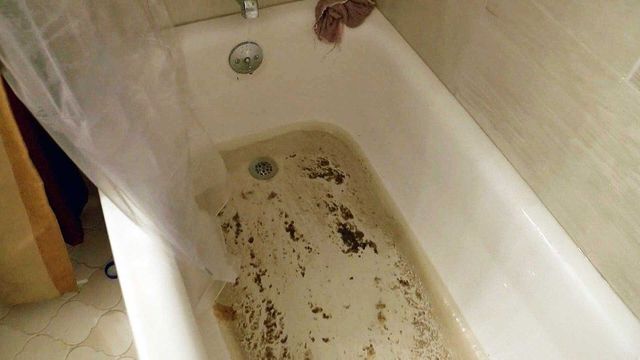Recommended Reasons for Sewage Coming Up in the Bathtub
Recommended Reasons for Sewage Coming Up in the Bathtub
Blog Article
We've stumbled on this great article on What to Do if Sewage Starts Coming Up Through Your Bathtub directly below on the net and thought it made sense to discuss it with you on this site.

Sewage backup in the tub can be a traumatic and unsanitary problem for any type of house owner. Not just is it troublesome, however it also positions severe health risks and suggests underlying issues with the plumbing system. Recognizing why sewage is showing up with the bath tub is crucial for taking appropriate activity to address the problem properly.
Intro to the Concern
Understanding the Trouble
When sewage draws back up into the bath tub, it's a clear indicator of an issue with the drain system. The wastewater that must be moving away from your home is rather locating its way back into your space, which can result in substantial damages and carcinogen.
Possible Reasons
Several factors can contribute to sewage back-up in the bathtub. From clogs in the drain line to issues with the plumbing infrastructure, identifying the root cause is essential for finding a remedy.
Common Factors for Sewage Back-up
Blockages in the Sewer Line
One of the most common causes of sewage back-up is a blockage in the sewer line. This can happen because of the build-up of debris, grease, or international objects in the pipelines, protecting against proper flow and triggering sewer to support into your tub.
Tree Root Invasion
Tree roots seeking wetness and nutrients can infiltrate sewer lines via tiny splits or joints. In time, these roots can grow and increase, triggering substantial damages to the pipes and bring about sewage backup concerns.
Aging Framework
Older homes might have outdated plumbing systems that are a lot more at risk to corrosion, fractures, and wear and tear. As pipelines age, they end up being much more vulnerable to leaks and blockages, enhancing the probability of sewage backup events.
Heavy Rainfall or Flooding
Throughout durations of heavy rainfall or flooding, the sewer system may become overwhelmed with excess water, triggering back-ups and overflows. This can lead to sewer supporting into tubs and various other components inside the home.
Health Dangers Related To Sewage Backup
Contamination of Water Supply
Sewer back-up can contaminate the water supply in your house, positioning a significant wellness danger to you and your family members. Direct exposure to polluted water can result in intestinal issues, skin infections, and other health problems.
Spread of Illness
Sewage consists of harmful bacteria, viruses, and bloodsuckers that can cause a series of conditions, including hepatitis, cholera, and gastroenteritis. Entering into contact with sewage or infected surfaces places you at risk of infection.
Mold Development
Dampness from sewer back-up can produce perfect conditions for mold and mildew development in your home. Mold spores can intensify respiratory system troubles and trigger allergic reactions in sensitive people, making punctual cleaning important.
Signs of Sewer Back-up
Foul Odors
Unpleasant odors emanating from drains pipes or fixtures, particularly in the restroom, may suggest sewage backup problems. These odors are usually solid and consistent, signifying a problem that requires prompt interest.
Slow Draining Fixtures
Bath tubs, sinks, and toilets that drain gradually or not at all could be experiencing sewer backup. If multiple components are influenced concurrently, it's likely that the concern originates from an usual point, such as the primary sewage system line.
Gurgling Noises
Strange gurgling or gurgling sounds originating from drains when water is running elsewhere in your house are indicative of air trapped in the plumbing system. This air buildup can arise from sewage backup and must be examined without delay.
Immediate Actions to Take
Switching Off Water
In the event of sewage backup, it's vital to turn off the water supply to prevent more contamination and damages. Locate the main water shutoff valve in your home and shut it off up until the concern can be resolved.
Getting In Touch With a Specialist Plumber
Taking care of sewer backup is not a do it yourself work. Get in touch with an accredited plumber with experience in handling sewage-related issues to examine the situation and carry out necessary repairs or cleanings.
Preventing Contact with Polluted Water
Till the sewage back-up is resolved, stay clear of contact with contaminated water to prevent the spread of germs and pathogens. Wear protective gear if you have to be in the damaged location and wash your hands extensively afterward.
Preventive Measures
Normal Maintenance of Sewer Lines
Arrange routine evaluations and maintenance of your sewage system lines to identify and attend to possible issues prior to they intensify into major issues. This can consist of cleaning debris, checking for tree root invasion, and repairing any kind of broken pipelines.
Mounting Bayou Shutoffs
Think about setting up bayou valves in your plumbing system to prevent sewer from receding into your home throughout durations of heavy rainfall or flooding. These shutoffs instantly close when water starts backing up, shielding your building from contamination.
Correct Disposal of Household Waste
Stay clear of flushing anything besides toilet tissue and human waste down the toilet to prevent clogs and obstructions in the sewer line. Dispose of grease, oil, and various other household chemicals effectively to reduce the threat of plumbing problems.
Cleaning Up After Sewage Backup
Disinfection Procedures
Thoroughly disinfect and sterilize affected areas after sewage backup to get rid of dangerous microorganisms and avoid mold development. Use suitable cleansing items and safety gear to ensure secure and effective cleanup.
Restoration of Impacted Areas
Fix any damage to floor covering, wall surfaces, or fixtures triggered by sewage backup. Relying on the extent of the damages, you may require to change carpeting, drywall, or other products to restore your home to its pre-loss condition.
Why Is Water Backing Up in My Bathtub When I Flush My Toilet?
What to do about a sewer line clog
First, don’t bother with plunging. No amount of plunging will dislodge the clog in a sewer line. The clog is too far away. Plungers are for clogs in the toilet itself, not the sewer line. Plus, the most likely causes of a sewer clog are:
Tree roots Flushed toys or feminine products Grease buildup Those items don’t move easily. And in the case of tree roots, the roots need to be cut out of the pipe and the pipe will need to be repaired.
You’ll need a closet auger. A closet auger is a type of plumber’s snake with a protective cover to keep from scratching the delicate porcelain toilet. If the clog is further down, you may need to remove the toilet or use one of your cleanouts to get to the clog.
We also recommend doing a video inspection of the drain to ensure that the cause of the clog has been completely removed. Otherwise, you could have the same problem again in a few days or weeks.
https://mspplumbingheatingair.com/blog/why-is-water-backing-up-in-my-bathtub-when-i-flush-my-toilet

I was introduced to that editorial on Water Coming up Bathtub Drain through an acquaintance on our other site. Are you aware of somebody who is curious about the niche? Why not promote it. Kudos for being here. Revisit us soon.
Book My Estimate
Report this page